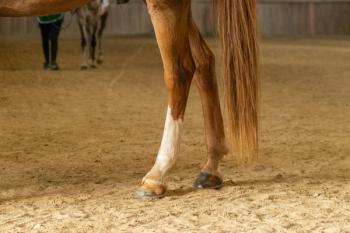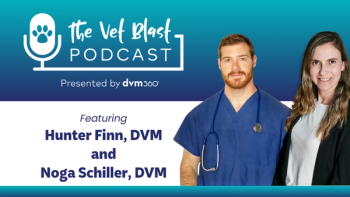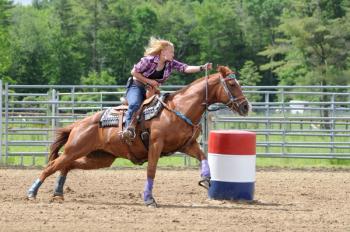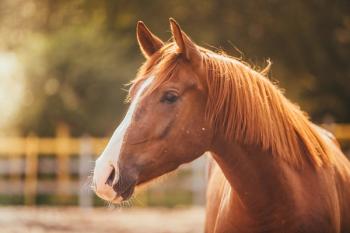
Understanding the disease progression of abnormal hoof anatomy, Part 2
How to meet the mathematical needs of the higher grades of laminitis.
In
Photo 1: The measurements used to provide mathematical accuracy when working with the equine foot: HLZ (horn-laminar zone), PA (palmar angle), SDT (sole depth under the tip of P3) and EP/CB (extensor process-coronary band).
Characteristics
Grade III laminitis has no observable external pathology, but the horse's foot pain appears to be so severe that the animal spends a lot of time recumbent. Radiographic indices show the following:
- The positive palmar angle is greater than or equal to 15 degrees.
- The horn-laminar zone (HLZ) may be as great as 25 to 30 mm.
- The extensor process-coronary band measurement (EP/CB) is increased.
- The sole depth under the tip of P3 (SDT) is greatly decreased, while the sole depth at the wing of P3 (SDW) is greatly increased.
- Soft tissue changes observed on a lateral radiograph will show disorganization of laminae and solar corium and possibly a lucent lamellar wedge.
The vascular region (observed via venography) will demonstrate the following (note: although there's controversy concerning the use of venography, some values will hold true):
- The coronal cascade will show constriction and marked congestion proximal to the extensor process of P3.
- The dorsal circulation will be decreased, and the solar corium fimbria will be absent or markedly shortened; circumflex vessels located at distal dorsal margin of P3 will be constricted.
- The terminal arch will not be affected.
- Bulbar circulation will have a full and healthy appearance.
- The distal margin of P3 will be partially or entirely below the circumflex vessels.
Symptomatically, the Grade III laminitic horse will walk forward reluctantly with a shuffling gait and a crouched hind end appearance. It may prefer not to make turns that would cause it to break over the dorsomedial or dorsolateral aspects of the hoof.
Treatment
Horses with Grade III laminitis will progress to Grade IV if not treated aggressively. Treatment involves an aggressive shoeing protocol or deep flexor tenotomy surgery. Which treatment to choose will depend on your diagnosis of a low or high Grade III event.
A low Grade III event (Photo 2) has the following characteristics:
- The palmar angle is within the lower numbers (e.g., 15- to 17-degree positive palmar angle).
- Good hoof mass is present.
- 10 mm or greater of healthy SDT is present.
- Tendons and ligaments have not had previous injury, scarring or adhesions.
- The horse has a good attitude (a calm and willing demeanor allowing for necessary treatment and nursing care).
- Pain is well controlled with low doses of NSAIDs.
Photo 2: A low Grade III laminitic event showing good SDT sole depth, a widened HLZ and a positive palmar angle of 15 to 17 degrees.
A high Grade III event (Photo 3), which requires deep flexor tenotomy surgery, has the following characteristics:
- The hooves show an SDT of less than 10 mm, or the sole is disrupted and of poor quality.
- There's poor hoof capsule mass (e.g., flat feet, brittle walls, flat or domed soles).
- Pain management is not achieved with low doses of NSAIDs.
- The horse is recumbent most of the time.
Photo 3: A high Grade III laminitic event showing about 2 to 3 mm of sole depth at the SDT, a widened HLZ, 18 to 20 degrees of positive palmar angle and a sole that is starting to dome.
If you've decided the mathematical protocol points toward an attempt at recovery of the feet without surgery, then the following criteria must be met:
- Create a zero-degree palmar angle under P3 through the solar area (measured along distal P3 surface and ground, radiograph block or shoe surface).
- Achieve a palmar angle of greater than 15 to 17 degrees to relieve the pull (tension) of the deep flexor tendon achieved through the application of heel height; this palmar angle is measured through the new zero-degree palmar angle and the ground surface (or x-ray block surface).
This type of shoeing follows a trim from the quarters of the foot to the widest part of the frog at the heels as you attempt to approximate a zero-degree palmar angle. Achieving a zero-degree palmar angle will stop compression of the blood vessels under the tip of P3. Note, a recent study found that increasing the palmar angle also increased the stored elastic energy at the dorsal laminar junction.1 The authors stated, however, that the stored elastic energy was minimal.
Fortunately, the dorsal laminae are perfused with blood from many arteries within the hoof capsule, and any circulatory compression that might take place is minimal when the heels are raised (Photo 4).
Photo 4: This venogram shows a recovering Grade III foot in the step-down process.The foot is showing a normal venography pattern for recovering laminitis.
If a zero-degree palmar angle can be achieved through trimming, then a raised heel appliance can be taped to the foot (Photo 5). The feet should be radiographed weekly to monitor sole growth at the SDT. Remember, a well-perfused solar corium will produce 1 mm of SDT a week. Once you’ve achieved 10 to 12 mm of healthy SDT, try to remove 5 degrees of heel height weekly. Follow the same heel-removal protocol as given below for the reverse wedge protocol.
Photo 5: A Grade III laminitic case that was successfully trimmed to a zero-degree palmar angle and is able to recover in a raised heel appliance.
<
If a zero-degree palmar angle cannot be achieved through a trim alone, then a reverse wedge must be added to the equation. Placement of the reverse wedge between the sole of the foot and the raised heel appliance makes up the rest of the need of the zero-degree palmar angle. The reverse wedge should be the number of millimeters missing under the SDT of the sole.
Confused? This may help: If you have an SDW of 8 mm and an SDT of 3 mm, then you know you need a reverse wedge of 5 mm (8 - 3 = 5) to accomplish a zero-degree palmar angle (Photo 6).
Photo 6: A high Grade III laminitic event that required a reverse wedge to recover successfully.
Note, the reverse wedge should never extend beyond the apex of the frog. If the horse shows immediate improvement and continues to improve on a daily basis, you will be successful treating this case using the reverse wedge shoe and raised heel appliance.
The feet should be trimmed and reset in a zero-degree palmar angle as soon as the palmar angle shows a significant increase. Don’t remove the reverse wedge until you have 10 mm of healthy sole at the SDT.
Once you've reached sufficient sole depth under the SDT, remove the shoe, and have a wedge cuff handy so you don't ask the horse to stand flat-footed when it's been accustomed to standing with more than 15 degrees of heel height. Trim the foot to a 1- to 2-degree positive palmar angle and reduce the heel height of your appliance by 5 degrees. If the horse remains comfortable at this height, both in the straightaway and on turns, leave this appliance configuration on for a week. Then attempt to take the feet down another 5 degrees. This is repeated weekly until the feet are capable of being barefoot or in standard shoeing.
Conclusion
The mathematical considerations of the foot are consistent in their application, no matter how severe the case may be. Should your Grade III laminitic case continue to deteriorate to a Grade IV, the mathematical considerations become more aggressive, and tissue pathologies will be present that may require surgery and definitely will require aseptic treatment. In part 3 of this series, I'll address the Grade IV laminitic foot.
Reference
1. Ramsey GD, Hunter PJ, Nash MP. The effect of hoof angle variations on dorsal lamellar load in the equine foot. Eq Vet J 2011;43(5):536-542.
Newsletter
From exam room tips to practice management insights, get trusted veterinary news delivered straight to your inbox—subscribe to dvm360.






